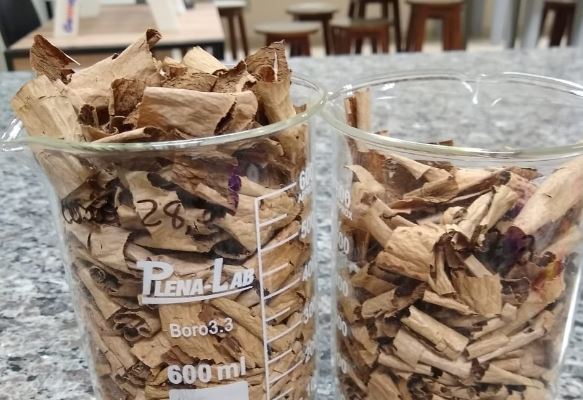Biotechnological obtaining of xylitol from cassava (Manihot esculenta)
DOI:
https://doi.org/10.20873/jbb.uft.cemaf.v8n3.pereiraKeywords:
cassava, fermentation, xytlitolAbstract
Xylitol is a sweetener with several human health benefits like the anti cariogenicity and no need insulin for the metabolism therefore, it can be consumed by diabetics, it can be obtained in three ways: extraction, chemical or biotechnological production. To obtain xylitol chemically or biotechnologically it is necessary to use materials containing cellulose and hemicellulose, because it is from the hydrolysis of these compounds that xylose is released and then reduced to xylitol. The objective of this work was to obtain xylitol from the xylose present in the cassava peel through the biotechnological way. For this, the peel went through preparation processes before fermentation, such as sanitization, drying, grinding and hydrolysis, and then the fermentation was done with the use of Candida albicans yeast. The xylose concentration obtained by the methodology used was 0.27 g/L, besides this sugar it was obtained 2.16 g/L of cellobiose, 0.18 g/L of glucose and 0.29 g/L of arabnose. At the fermentation stage, the concentration of some products was not detected by the liquid chromatography reader. Therefore, the cassava bark has fermentable sugars that can be used to obtain products, so their disposal is not the only targeting option for this byproduct.
References
Cabral A, Ferreira J, Trinca N, Garcia-Cruz CH. Hidrólise da casca de mandioca (manihot esculenta crantz) em diferentes tempos de tratamento e concentrações ácidas para a obtenção de açúcares fermentescíveis. Anais do fórum de iniciação científica do UNIFUNEC, v.6, n.6, 2016.
Canettieri EV, Silva JBA, Felipe MGA. Obtenção biotecno-lógica de xilitol a partir de cavacos de eucalipto. Revista Brasileira de Ciências Farmacêuticas, v.38, n.3, p.323-331, 2002. https://doi.org/10.1590/S1516-93322002000300008
Dasgupta D, Bandhu S, Adhikari DK, Ghosh D. Challenges and prospects of xylitol production with whole cell bio-catalysis: A review. Microbiological Research, v.197, p.9-21, 2017. https://doi.org/10.1016/j.micres.2016.12.012
De Brito RS, Brito RS, Moreira VJG, Oliveira AV. Produ-tividade de mandioca na região do Vale do Juruá, Amazônia Ocidental. Scientia Naturalis, v.1, n.1, p.1-9, 2019.
De Souza RM. Produção de xilitol por linhagens de leveduras do gênero Cyberlindnera. Dissertação de Mestrado - Pro-grama de Pós-graduação em Microbiologia do Instituto de Ciências Biológicas, Universidade Federal de Minas Gerais, Belo Horizonte, 2019.
Dourado DP, Macedo DA, Tonani FL, Muraishi CT. Carac-terização bromatológica e classificação da casca da mandioca como fonte para alimentação animal. Revista Integralização Universitária, v.16, n.12, p.22-30, 2017.
Knychala MM. Transporte e fermentação de xilose, celobiose e xilobiose por leveduras Saccharomyces cerevisiae recom-binantes. Tese de Doutorado - Programa de Pós-Graduação em Biotecnologia e Biociências da Universidade Federal de Santa Catarina, Florianópolis, 2017.
Kumar V, Sandhu PP, Ahluwalia V, Mishra BB, Yadav SK. Improved upstream processing for detoxification and recov-ery of xylitol produced from corncob. Bioresour Technol., v.291, p.121931, 2019. https://doi.org/10.1016/j.biortech.2019.121931
Mussatto SI, Vaz ACS, Roberto IC. Efeito da concentração inicial de xilose na produção de xilitol a partir de hidrolisado de bagaço de malte. VIII Encontro Latino-Americano de Ini-ciação Científica, São José dos Campos/SP. Anais/CD-ROM de trabalhos completos, p. 527-530, 2004.
Riley M, Locke AB, Skye EP. Health maintenance in school-aged children: Part II. Counseling recommendations. Ameri-can family physician, v.83, n.6, p.689-694, 2011.
Ur-Rehman S, Mushtaq Z, Zahoor T, Jamil A, Murtaza M. Xylitol: a review on bioproduction, application, health bene-fits, and related safety issues. Critical reviews in food sci-ence and nutrition, v.55, n.11, p.1514-1528, 2015. https://doi.org/10.1080/10408398.2012.702288.
Yewale T, Panchwagh S, Sawale S, Jain R, Dhamole P. (2017). Xylitol production from non-detoxified and non-sterile lignocellulosic hydrolysate using low-cost industrial media components. 3 Biotech, v.7, n.1, p.68, 2017. https://doi.org/10.1007/s13205-017-0700-2

Published
How to Cite
Issue
Section
License
Copyright (c) 2024 - Journal of Biotechnology and Biodiversity

This work is licensed under a Creative Commons Attribution 4.0 International License.
Authors who publish with this journal agree to the following terms:
Authors retain copyright and grant the journal right of first publication with the work simultaneously licensed under a Creative Commons Attribution License (CC BY 4.0 at http://creativecommons.org/licenses/by/4.0/) that allows others to share the work with an acknowledgement of the work's authorship and initial publication in this journal.
Authors are able to enter into separate, additional contractual arrangements for the non-exclusive distribution of the journal's published version of the work (e.g., post it to an institutional repository or publish it in a book), with an acknowledgement of its initial publication in this journal.
Authors are permitted and encouraged to post their work online (e.g. in institutional repositories or on their website) prior to and during the submission process, as it can lead to productive exchanges, as well as earlier and greater citation of published work (Available at The Effect of Open Access, at http://opcit.eprints.org/oacitation-biblio.html).


